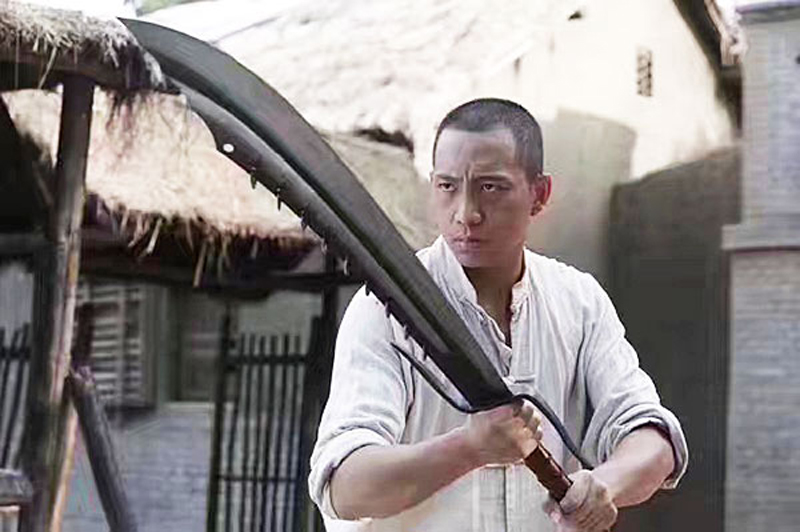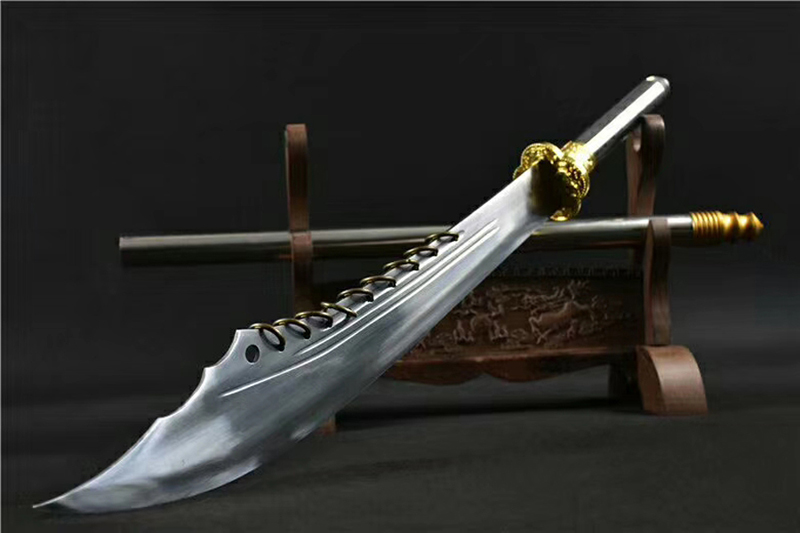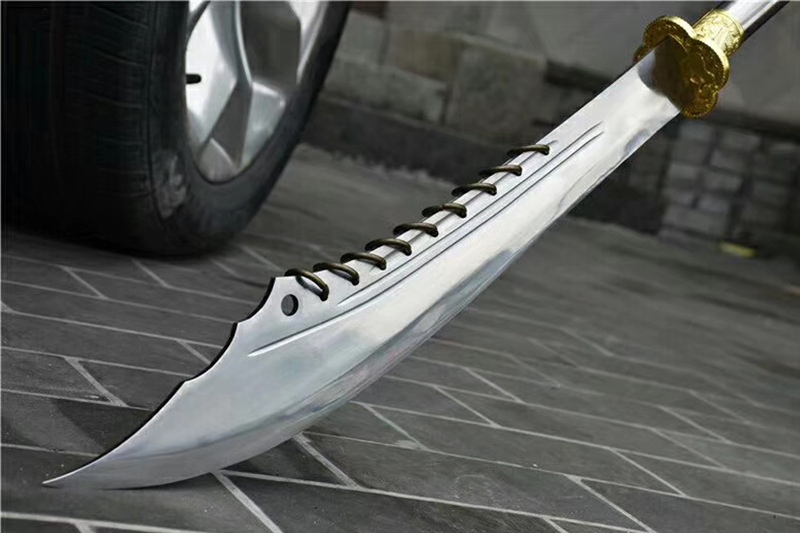What is the function of the rings on broadswords?
07 Sep


11 Comment(s)
158618 View(s)
We often see the broadswords with rings on the blade back in the movie and TV series. Some broadswords are usually named after the number of rings. There are indeed ring-broadswords in ancient weapons, but what is the function of the rings?
1. Inertia, adjust the center of gravity, increase the slashing and lethality.
When the broadsword is erected, the rings hang down, and the center of gravity of the sword will be offset in the direction of the hand, so that the hand can control the whole sword.
When slashing with force, the rings will move forward with inertia, and the center of gravity of the sword will shift toward the direction of the cutter head, thus increasing the slashing and lethality.
2. Forestall the enemy by a show of strength, shocking and intimidating the enemy.
When confronted with the enemy, shake the ring, make a creaking sound, and publicize your voice to shock and intimidate the enemy.
3. Be confident and never stab in the back.
The martial arts masters are usually very confident in their martial arts. When they compete with their opponents, they dance their broadswords in their hands and shake the ring to make a sound, indicating that he is a bright and straightforward match with his opponent, and never hurt anyone with a stab in the back.
4. Hook the ring, easy to draw the sword.
When cutting vigorously, some wide and heavy swords are easy to cut in but can not be drawed out. This situation will also be encountered when we cut wood and bones in our lives. When the ring broadsword is cut in very deep, it is very difficult to pull out the sword by gripping the handle. At this time, you can use the finger of the other hand to hook the ring and forcefully draw the sword together.
Click following link to order HanBon Forged Nine Rings Broadsword
Want a unique sword? Feel free to contact us:
Phone: 086 13739276006
Email: [email protected]
Website: www.hanbonforge.com
Custom Sword Page: www.hanbonforge.com/CUSTOM-SWORDS/Custom-Your-Own-Swords
Phone: 086 13739276006
Email: [email protected]
Website: www.hanbonforge.com
Custom Sword Page: www.hanbonforge.com/CUSTOM-SWORDS/Custom-Your-Own-Swords




11 Comment(s)
There is no way the rings moving forward or back create any appreciable difference in the sword's power or handling, I seriously doubt the rings were anything other than ornamental.
I disagree...let's not forget they the rings themselves are made of metal, meaning that it has some weight, although light, it can still affect the center of gravity of the sword...balance a ruler for example, if you add a penny on one side, it shifts...same principle...
Just because it has weight does not mean it will have any significant impact on the cutting power. Sure it will alter the center of balance slightly, but we're talking on the scale of a few millimeters, perhaps centimeters, forward or back. Such a difference will do little more than making it slightly more top-heavy, and more difficult to wield while providing no noticeable increase to cutting capability.
They do not say the weight of the rings or the rings themselves cause the slash to be greater, its the POSITION of the rings when hanging or when thrusting. The position of the rings helps to indicate the sword blade is in the best position to penetrate your opponent's body.
Any sort of metal ring will change the weight distribution. Typically dao/broadswords have their center of balance further out than say a jian or rapier. This allows for heavier cuts at the expense of those quick turns and reactions. With the ring distribution, your weight is going to be further out still. That doesn't mean more difficult to wield. It just changes the style and directionality of your blocks and counters. You'll see a lot more wrapping movements to bring those weights around the body and counter attack from the other side.In Kung Fu practice today, the assumption with any dao is that your opponent is armored and that the change in weight is for dealing with say cloth armor at the neck or armpits. Because of this, strikes are lot more percussive and you may thrust with the blade up to break into armor. The wielder may even have his hand on the spine. My assumption is that the rings add to that percussive force along with the slicing in place of the second hand for instances where the wielder may have a shield or may not want to close distance to get that extra force.Any hole in the weapon is going to reduce the overall strength so I highly doubt it would be done without reason.
If you have a sword with rings and don't see a difference you have the wrong weight rings. Chances are it is ornamental. The momentum of the rings from the hanging position to whipping around as you strike downwards, hitting the back of the blade when you make contact with your target is noticeable. But if you test on something extremely dense you won't notice that much. If you test on ballistic gel you'll never question if it makes a difference again.
According to forged in fire, the rings are there to ward off angry spirits with the sounds
Hmm. I had always considered the rings to through out the balance of the weapon, and ad a small amount of weight in a disadvantageous way, to assist with training. Strengthen the wrist, induce more focus on control and so on.
Granted, I've not trained with the 9-ring broadsword as of yet (I start a class next month), so I am speaking from a place of ignorance, but in practice swings and attempting to use the 9-ring win place of my normal dao, it does throw me off a bit.
So, these city slickers think they know better than all the warriors of the last thousand years what works and what doesn't? Hah, must be retard day on hanbonforge! Ever had to wield a sword in battle? Ever had to pull a sword lodged in a head or into a torso? They don't come right back out. The rings will help you dislodge it.
Also, there is a suction that takes place when you stick anything inside a human or animal body. That is why butcher knives and cleavers have holes in them. So the air can get in so you can pull them back out. The rings can serve a similar purpose. Obviously it's pretty gross so no one mentions it. When you are on a battlefield of 100s or thousands of enemies, you'll want that weapon back out in a twist and a pull a fraction of a second or you die.
I always laugh at people who do no research but post erroneous bullshit on topics like this. There are so many of them these days.
I call it the "Earl of Sandwich effect. When I was a kid I was told the Earl of Sandwich died from eating too many sandwiches when I asked how he died. Last bullshit I ever believed.
You said:"That is why butcher knives and cleavers have holes in them. So the air can get in" Wrong! Those holes are a holdover from the days when most butchering was done at home out behind the barn. They were there so the knife or cleaver could be hung on a peg or a nail. They carried over into the neighborhood butcher shop where hooks were used. These days the magnetic strips available you'd be hard-pressed to find a commercial grade butcher knife with a hole in the blade
Holes = hanging groove = anti suction santoku = anti-suction for vegetablesAny more?
I do not think these swords were used by the military of the Qing, it was just peidaos.
Yeah, I'm not buying the inertia thing. You want center of gravity on a sword closer to the hilt, otherwise its just an axe that looks like a sword. This is an axe that looks like a sword. I think there is something to the jingling to ward evil spirits, these were typically superstitious people. The rings might be useful for pulling that heavy cleaver free of armor and flesh, but they might also be added for a bit of drag to prevent you from burying the blade too deep in flesh or light armor and getting it stuck. That was actually my first impression when I first saw a sword like this, that the rings were to counter the momentum of the sword when it goes deep, drag on the backside to keep it from sinking all the way in and becoming trapped under cleaved armor. If you're planning on an extended battle, this is not the sword to carry, something lighter, on the order of three pounds, unless you're facing mounted, then a longsword or spear for reach. I think this sword is more suited for intimidation effect in limited combat, like a dual. I couldn't imagine having to swing this bitch all day long, I think after an hour or so you'd drop it and pick up a lighter tool.
(I know this thread is old) Just so you all know in personal experience in making and using swords the rings definitely have an impact with the blade mostly in a stabbing motion it increases force and the rings are used in a way to balance the blade.
I'm inclined to believe the rings are strictly for ceremonial, decorative, or spiritual purposes. I haven't seen here or on the wider internet any practical advantage that isn't outweighed by the several impracticalities. There are things that nobody wrote down about pre-gunpowder weapons, and we moderners can only speculate. Nobody should feel bad about that. Look how wrong various old timers got it when they predicted how we'd be living in the 21st century.
I know this thread is old but it is a top result when searching up these types of swords.
These rings were primarily used to protect the blade as Dao sabres were seen as less noble and cheaper/easier to learn compared to longer, thinner and less curved Jian swords which were more popular with the aristocracy. These types of sabres were typically found on more common soldiers or guards and many techniques involved using circular block/attack patterns which would use the back of the sword to deflect an attack to protect the edge of the blade. Having easily replaced rings meant the sword would have a longer effective lifespan as the rings would be sacrificially damaged in combat and keep the blade true for longer. The significance of 9 rings is that 9 is considered an auspicious number as it is the largest number in base-10 and therefore the "number closest to heaven".
The history of this type of Dao precedes the Qing, possibly all the way to the Song dynasty known for its development of "exotic" weaponry. Not army issue, but definitely "bandit" used. Although the "intimidation" factor is real, the obvious is being overlooked i.e. the lightening of a massive blade as a whole (without weakening the spine, hence the holes), and its balancing with possibly different types of metal rings. The 9 is indeed a numerological auspicious number. The theory of the rings protecting the spine with certain techniques sounds plausible but that would almost imply the use of "split" rings for replacement. Contrary to a lot of modern versions, this is not the case in more antique ones where the rings are solid...
Thank you for caring enough to comment on something you have put time into finding the answer for 7s all!!
Wow are any of you people Asian or at least know of their culture or do you have any idea how STUPID you sound? The person who gave us an answer was trying to help your curiosity if you don't agree at least research it yourself before passing judgement or giving your opinion as if you were a specialist in this matter!!
Leave a Comment